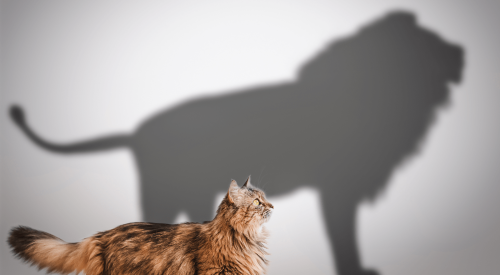Remember "Carnac the Magnificent," Johnny Carson's fortune-telling alter ego? Carson wasn't the only one; I can predict the future, too. Just follow along and you'll see what I mean.
Prime Time Viewing |
Picture this: I'm playing the role of Johnny; you're playing the role of Ed. You've just handed me the first envelope, and I hold it to my forehead, close my eyes and say, "commodity." You repeat the word as I tear open the envelope and read the first answer: "What word should builders fear most?"
Our builder audience is suddenly alert as you hand me the next envelope and the process repeats. "Incentive wars," I say before reading my answer: "What happens when your product is a commodity?"
By now builders are sneaking side-glances wondering what will come next. "Differentiation," I say in a strong voice before following up with the next answer: "What strategy will allow you to reduce incentives and still capture the sale?"
Tension is in the air as I call for the last envelope and boldly make my prediction. "Customer Experience," I say. Again, I tear open the envelope and read the answer: "What's the easiest, most effective and budget-friendly way to differentiate yourself from your competitors?"
It's the ExperienceDifferentiating in terms of your customer's experience is the easiest, quickest, most effective and budget-friendly way to make more sales. All you have to do is think a little differently than you do right now. But there's a twist. I want you to think about your customer's experience in a different way; I want you to think about it before they buy.
New FindingsI went outside the industry and asked Tony Kirton, president of Experience Studio in Scottsdale, Ariz., to provide his insight into customer experience.
Tony is the former director of marketing for Audi North America and has helped develop brand experience strategies for a diverse range of major national brands, including Boeing, Peterbilt, Diet Coke, Dodge and Fairmont Hotels, as well as for some of the most successful developers of large-scale master-planned communities in America. Here are my questions and a round up of Tony's responses.
Q. WHAT IS THE BIGGEST OPPORTUNITY FOR MARKETERS TODAY?
A. If you are willing to invest the time and energy, the big opportunity for marketers lies in understanding the application potential of new discoveries in how we think, feel and respond to the varied experiences of life — like shopping for a new home. For example, neuroscientists can prove that 95 percent of how we think and feel is not only processed in the unconscious mind, but that this unconscious processing influences and guides the choices we make more directly and powerfully than we had ever believed possible.
This is a huge opportunity for sales and marketing professionals to bring real science to what has been a largely intuitive guessing game.
Q. WHAT ARE THE IMPLICATIONS FOR BUILDERS?
A. Huge. Visit a model home, for example, and think about how your customer's experience unfolds as a series of sensory inputs. Now imagine that 95 percent of the input is being processed at warp speed in the unconscious mind of your prospect.
Professor Gerald Zaltman of the Harvard Business School — he's recognized as one of the top five marketing thinkers in the country — puts it this way: "By the time we are consciously aware (of feelings, experiences, people, sounds, smells etc.), the underlying framework of a decision has already been established (in our unconscious mind)." This framework begins to influence how we think and feel at the conscious level without our being aware of it.
Q. WHAT OPPORTUNITIES DO YOU SEE TO ENHANCE THE MODEL-HOME EXPERIENCE?
A. A model-home experience accumulates as a series of sensory inputs that either creates a memorable impression or doesn't.
To find specific opportunities, try this exercise: create a list of all the sensory inputs you can think of when the prospect first sees the model-home sign, drives into the parking area, walks up the path, walks into the sales office and is greeted by the salesperson. Identify every possible input by sense: what do you see, hear, smell, touch and taste if you offer refreshments?
Rank each input as positive, neutral, or negative. Then ask what you can do to turn every negative into a positive or at least a neutral sensory input.
Get your whole team involved. Ask a group of customers to repeat the process. Then ask a group of women to do the same thing. Compare the results. Prepare for a big surprise.
Q. WHAT WOULD YOU TELL SALESPEOPLE?
A. The same principles apply. Let's take opening the sale, for instance. Customers process their experiences in a sequence that begins with an initial instinctive response shaped by our unconscious processing of the inputs.
At this point the right brain kicks in with a big picture, intuitive assessment, which is followed by a left-brain analysis and rationalization. The sequence is always the same.
One of my messages to salespeople is make sure your "framing" — where you stand, how you stand, what your face says — is perfect before you say anything. The critical first impression is mostly instinctive. This allows the unconscious mind to sort the sensory inputs into a feeling that begins to affect their response.
The right brain continues to reinforce the first impression as either a positive, neutral or negative based on the continuing stream of sensory inputs. Once the conversation between the salesperson and the visitor begins, the left-brain begins to analyze and rationalize the sales presentation (positive-neutral-negative).
It is the combined effect of the instinctive, intuitive, rational experience that shapes the response, creating that magic moment when mutual empathy takes over and you're in the zone.
Q. DOES THIS RESPONSE MODEL APPLY TO COLLATERAL, ADVERTISING AND WEB SITES?
A. Yes. Great creative people intuitively understand how this works. The moment we begin to give our attention to advertising, collateral or Web sites, the initial instinctive response is primarily a function of color, texture, headline and use of white space, plus a million other details picked up and processed by the unconscious mind. The right brain takes in the big picture of the overall aesthetic of the design, music, images and movement.
All this occurs in such a fleeting moment that 99 percent of the time we've moved on before conscious recognition even begins. But if the ad does the job of capturing our attention, we have a chance to build value and make the rational offer with our customer listening.
Q. WHAT'S ONE THING BUILDERS CAN DO TO FIND OUT IF THEY ARE PROVIDING A GREAT CUSTOMER EXPERIENCE?
A. The most important question is to ask your customers what they think you think of them. The answers to this question will be much more revealing. So often, we "drink our own Kool-Aid" — we believe that we care, that we demonstrate respect and that we can be trusted. We believe that our sales process is good. But what matters is whether the customer believes it.
The answers to the question, "What do you think we think of you?" will get you a more complete and accurate picture of your customers' true perceptions.
| Author Information |
| Rick Heaston is president of R.A. Heaston and Co., a sales-training and marketing firm. You can reach him at rick@touchpointselling.com. |










